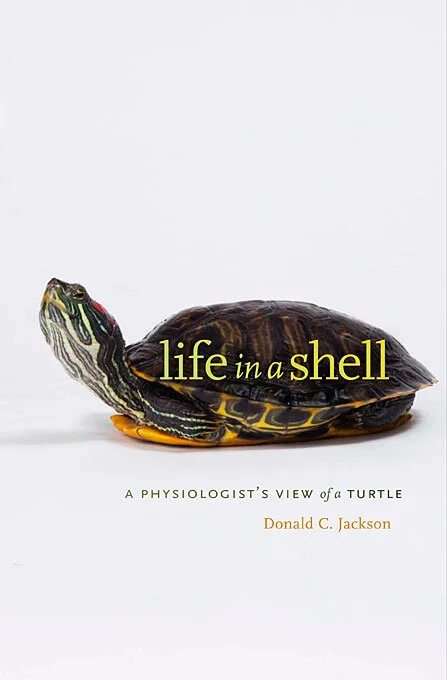In Paperback: Life in a Shell
/In Paperback:
Life in a Shell: A Physiologist's View of a Turtle
by Donald C. Jackson
Harvard University Press, 2013
“Turtles are patient and persistent but also inscrutable,” Donald Jackson writes in his intriguing and delightfully nerdy book Life in a Shell: A Physiologist’s View of a Turtle (now out in paperback from Harvard University Press and a mandatory addition to any self-respecting turtle library), and he’s certainly right, although not from want of trying on his part and the part of his fellow specialists. Turtles have been on Earth for well over 200 million years; they were already an old and worldly-wise life-form when dinosaurs began their climb to gaudy clamor, and they were plodding through the undergrowth and gliding through mangrove shallows when cataclysm claimed the dinosaurs and left the world open for the rise of mammals.
They have perfected the art of minding their own business. They have sublimated the very tempo of their lives into a dream state virtually all other forms of animal life would find incomprehensible. They don’t yield their secrets easily, not because they guard their secrets, but because they are their secrets.Jackson has tracked them and tagged them and questioned them for his entire professional life, in almost all of the places they go. He fills his genial, fact-heavy book with what answers he’s found to some of the questions that underscore just how strange turtles are. How do they navigate the vast distances and crushing depths they routinely travel? How do they breathe, when their shells prevent their ribcages from expanding? For that matter, how do they manage to go without breathing, during the frequent – and mind-staggeringly long – intervals when they opt not to? It’s possible humans might already have some of the answers to these questions if their relationship with turtles for the last ten centuries hadn’t been one of relentless, indiscriminate slaughter, but Jackson is doing what he can to make up for lost time.
He begins with simple categories. There are two types of these ancient animals: the Pleurodires and the far more populous Cryptodires. And the essential difference, as you might imagine, hinges on that most essential of all turtle traits: their relationship with their shells:
A Pleurodire, or side-necked turtle, rotates its neck laterally so that the head and neck lie snugly against the upper part of the body. A Cryptodire, in contrast, pulls its neck straight back, and as the neck folds, the head is brought safely within the shell. The muscle that retracts the neck in a Cryptodire, the retrahens capitis, is a large and powerful muscle, as anyone who has tried to forcibly pull a turtle's head out of its shell realizes.
And as he moves on from the simple to the more complex, he retains always the ease and clarity of explanation that defines the best kind of teacher. Each odd fact – such as that most turtles don’t seem to be able to breathe and exert themselves at the same time (something that won’t come as a surprise to anybody who’s ever stood next to a great leatherback as it heaves itself up the sand):
Why should a green turtle not be able to breathe and exercise at the same time? Certainly we and other mammals can breathe as we run, and birds can breathe as they fly. The reason is that we use different muscles for the two functions. Mammals evolved a diaphragm that is committed to breathing and not involved with running. Indeed, locomotion, whether running or flying, enhances breathing in many mammals. Perhaps performing the two functions simultaneously is only a problem for lower vertebrates, such as reptiles.
Even the turtle’s single strangest trait – its largely elective relationship with oxygen, the weirdly diffident way it can decide to go about breathing – is something Jackson finds a way to relate to human life:
We cannot easily identify with a turtle holding its breath for many weeks in a frozen pond, and it is hard to believe that we share an experience that is in any way comparable to this. But as developing fetuses in utero, we have all experienced a situation similar in important respects to that of an overwintering, submerged turtle. Within the womb, oxygen delivery into fetal blood occurs not in the lungs but in the placenta…
It isn’t enough, of course; even at the end of this welcoming little book, turtles still remain the ultimate anomalies among us (tellingly noted in the fact that in the wonderful 1980 PBS production of Ursula Le Guin’s The Lathe of Heaven, the aliens are basically spacefaring sea turtles). But readers will know a lot of what can be known, and the learning will have been very enjoyable.

